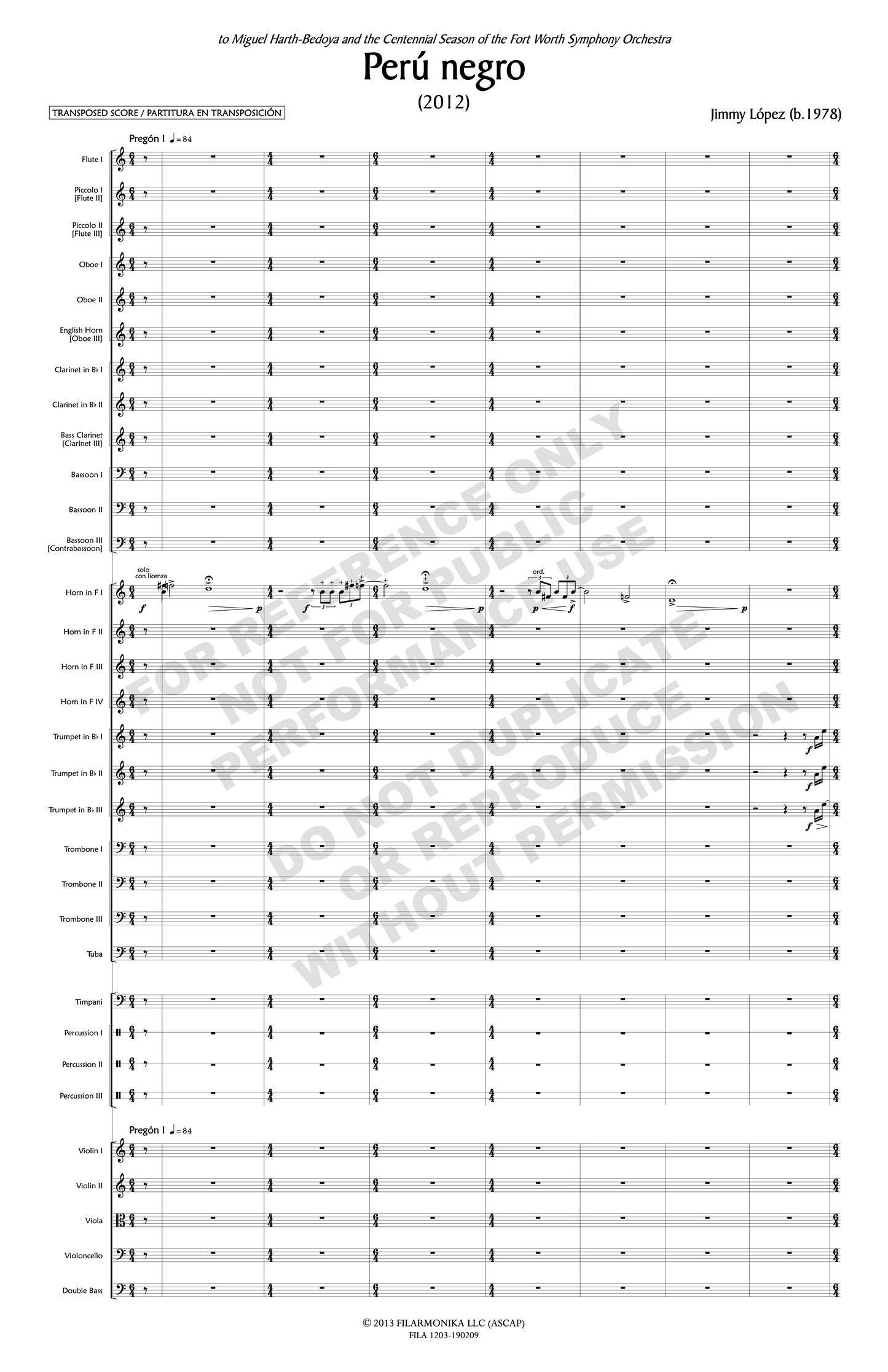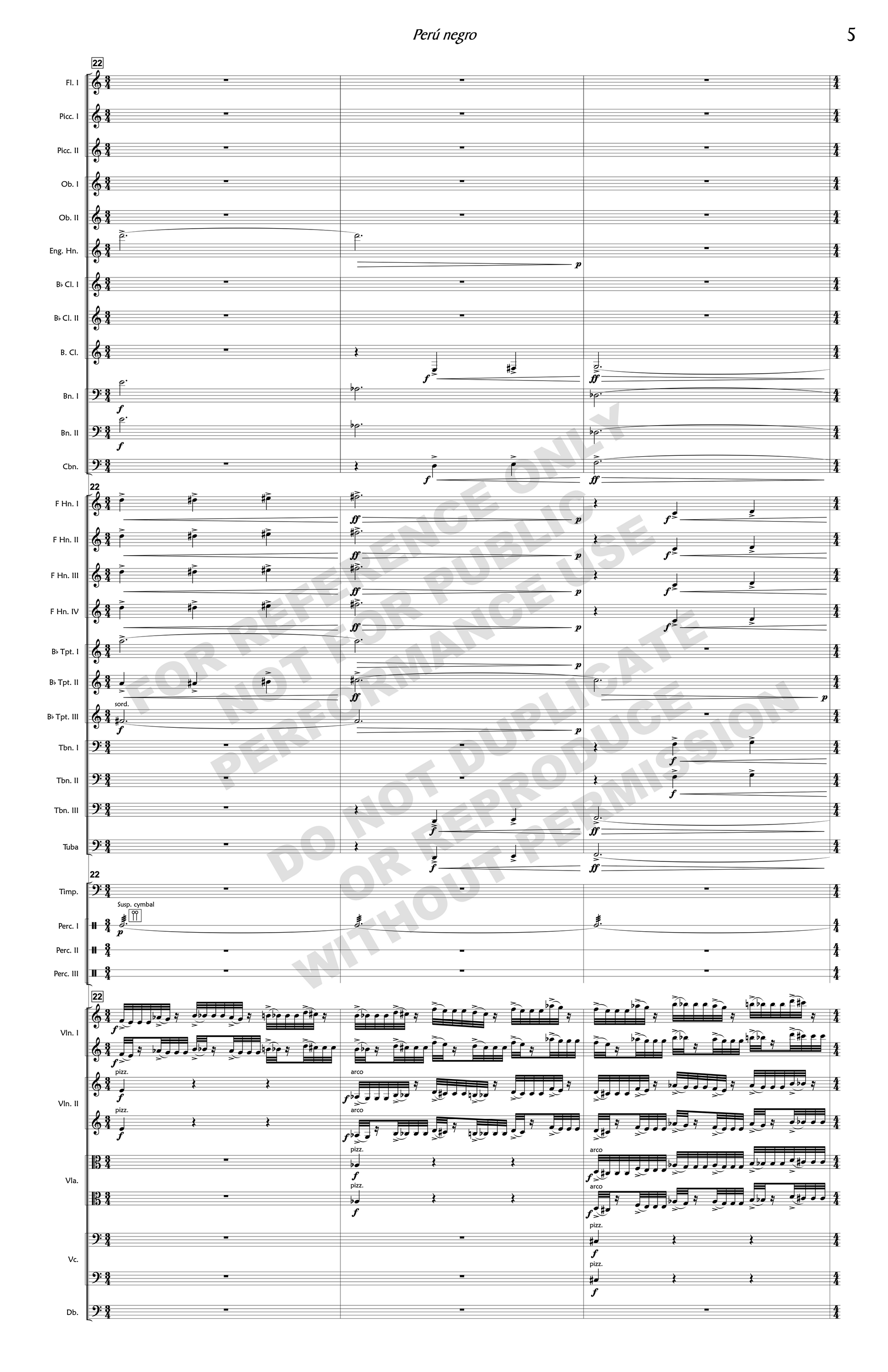Jimmy López
Perú Negro, for orchestra
Perú Negro, for orchestra
Couldn't load pickup availability
 2012
2012
- 16:00
- 3*3*3*3*-4331-timp-perc (3)-str
This work is available for rental only. Please fill out our rental request form here to begin the rental process.
Perú negro was commissioned by Miguel Harth-Bedoya to celebrate the centennial season of the Fort Worth Symphony Orchestra.
"Miguel and I have collaborated closely for a number of years, and instead of simply dedicating the piece to him, I decided to imprint it with his initials right from the beginning. The first motive, played by the horn, establishes the notes E, B, Bb and G, which correspond to Miguel (Mi = E) Harth (H = B natural) Bedoya (B = B flat) Gonzáles (G). These four notes rule the intervallic and harmonic structure of the entire piece.
The main source of inspiration for this work is Afro-Peruvian music, but although the piece makes reference to six specific traditional songs, it is indeed very personal. I did not attempt to merely copy or reproduce Peruvian folklore. On the contrary, I assimilated it and created something entirely new and personal -an invented folklore of sorts, which bears the seal of my musical language.
The introductory section, “Pregón I”, captures the spirit of the old street- sellers, which used to walk the streets of Lima announcing their goods and creating miniature songs in the process. These songs became extremely popular among the people of the city and some of them have survived until today. When in a musical context, they usually appear in the form of question-answer. In “Perú Negro” different sections of the orchestra play the main motif and later that same motif is answered by the full orchestra.
“Toro Mata”, the second section, is a traditional song in slow tempo with a very striking characteristic: the ascending perfect fifth, which, coincidentally, is also the interval produced between the notes E and B natural (the first two notes of the piece). In this way, this traditional melody has been embedded into the core of the piece, now constituting one of its building blocks.
The following section “Ingá” steps up the tempo considerably and lets the string section take center stage. The melodic gestures are directly derived from this song, but the melodies are adjusted to fit into the model set forth by the initial motive.
“Le dije a papá”, the fourth section, is agile and virtuoso and it reaches its climax right before “Pregón II”, marking an important structural divide. The percussion section rises and its propulsive energy brings us to a climatic moment where the orchestra, now in full force, reaches a sudden stop.
“Pregón II” is based on the first section of similar name, but the main motive is now transformed into a monumental musical phrase performed by brass and percussion in fortissimo. When the strings come in, a long-breathed melody, based on “Toro Mata”, takes over, creating a sustained build up that leads us to the final section.
“Son de los Diablos”, the fastest and final section, brings the piece to a close in a frenzy of Afro-Peruvian rhythms. The main four notes are brought back toward the very end concluding in unison on E, which is the very first and now the very last note of the piece. As it can be inferred from the above description, the general tendency of this piece is to increase in tempo and activity, and although the progression is not linear, it can be felt as an overriding arch moving the piece forward.
“Peru Negro” is an homage to our Afro-Peruvian heritage but it also stems from a personal desire to assimilate Peruvian folk music to the point of blending it seamlessly with my own language. I leave it to the listener to judge whether this attempt has been successful.
The premiere of Perú Negro took place on May 17, 2013 in Fort Worth, Texas, by the Fort Worth Symphony Orchestra conducted by Miguel Harth-Bedoya."
Jimmy López © 2012



















